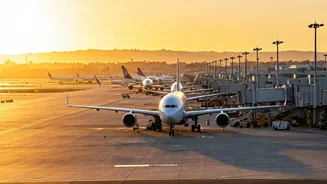LAX Flight Halt
The air traffic control system at Los Angeles International Airport (LAX) experienced a significant setback, causing flight operations to be greatly affected.
The primary reason for the disruptions was a deficiency in air traffic controllers. The shortage impacted flight schedules, with multiple delays and cancellations reported. This situation caused significant inconvenience for passengers, leading to disruption of travel plans. The problems at LAX serve as a case study, underscoring the vital role of air traffic controllers in the efficient running of air travel. It highlighted that any shortage of essential personnel can result in wide-ranging consequences for the airline industry, causing disruption and affecting the broader air travel network. The situation at LAX has brought the need for thorough preparation to the forefront, as well as the need for long-term strategies for personnel and resilience in the face of possible workforce problems.
Cause: Staff Shortage
The main culprit behind the problems at LAX was a lack of adequate air traffic controllers. These professionals have the important job of safely managing the flow of aircraft in the skies and on the ground. A shortfall of these specialists put pressure on the remaining personnel, as they had to manage a heavier workload, which is potentially a stressful situation, as they work to maintain safety and efficiency. Possible reasons for the controller shortage could range from retirement and career changes to difficulties in the recruitment and training of new staff. The shortage underscores the vital need for careful workforce planning and sustainable staffing in air traffic control. Additionally, it highlights the need for effective measures to maintain enough personnel to keep up with the demands of air travel, which is continuously evolving. This is a crucial element in maintaining safe and smooth flight operations.
Traveler Impact
The effects of the air traffic controller shortage were felt by many travelers using LAX. Several flights were delayed, leading to disruptions in connection plans and overall travel schedules. Passengers experienced inconvenience, with potential changes to their itineraries, which included having to stay longer at the airport, possibly missing connecting flights, or having to deal with the stress of last-minute adjustments. Airlines have a responsibility to address passenger concerns during these types of disruptions. This might include giving out timely updates regarding flight status, helping passengers to rebook flights, and offering other forms of assistance. The circumstances at LAX emphasized the wider implications of issues like controller shortages on the passenger experience. It brought to light the need for airlines and airport operators to have crisis management plans, particularly when facing sudden and unexpected situations that can affect a large number of passengers.
Addressing the Issue
Several actions were taken to deal with the air traffic control shortage at LAX. Authorities implemented strategies aimed at mitigating the disruption and assuring smooth operations to the greatest extent possible. This may have included directing flights to other airports when needed, making adjustments to the arrival and departure schedules to ease the pressure on the controllers, and concentrating on the most important air traffic movements. There were also longer-term strategies that centered on addressing the root causes of the controller shortage, such as intensifying recruitment, improving training programs, and exploring ways to retain current staff. These initiatives indicated a proactive and multifaceted method for facing the crisis, highlighting the importance of cooperation between aviation authorities, airports, and airlines. The goal was to reduce the negative impact on travelers and to restore normal flight operations.
Wider Aviation Implications
The difficulties at LAX have drawn attention to the bigger challenges in air traffic control management. The occurrence serves as a warning that any shortage of critical personnel can affect the whole air travel ecosystem. The incident at LAX has highlighted the necessity of investing in the workforce, ensuring that there are enough well-trained professionals to meet the demands of air travel. It also revealed the significance of investing in technology and infrastructure to assist air traffic controllers, improving their productivity and safety. The incident at LAX emphasized the significance of a resilient air travel system, which is capable of managing disruptions and adjusting to shifting situations. This involves efficient crisis management, clear communication protocols, and a focus on keeping passengers informed throughout the course of an unexpected event. It is a reminder that constant attention and a commitment to improvement are required to ensure the continued safety and efficiency of air travel.
















